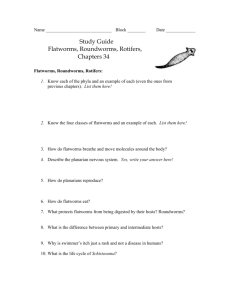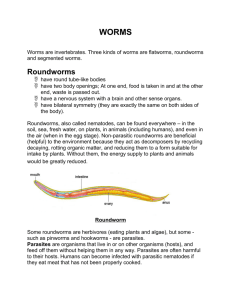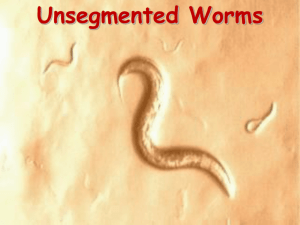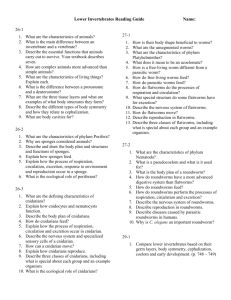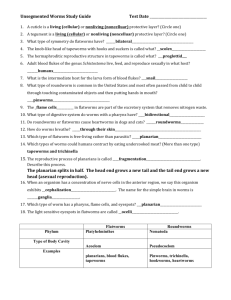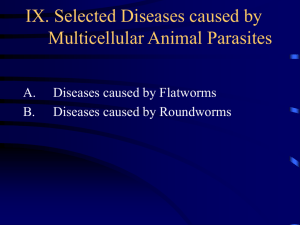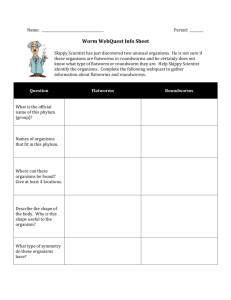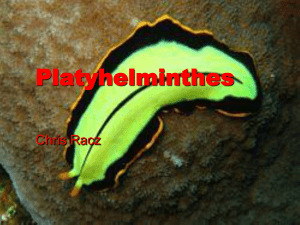Phylum Platyhelminthes - Emerald Meadow Stables
advertisement
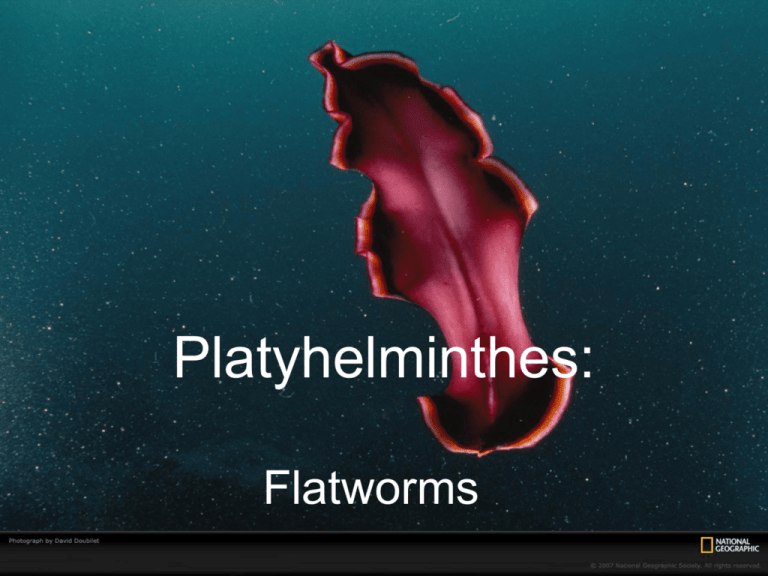
Platyhelminthes: Flatworms Phylum Platyhelminthes • Phylum Platyhelminthes - Flatworms • Soft, unsegmented, flattened worms that have tissues and internal organ systems • Have three embryonic germ layers • Simplest animals with bilateral symmetry • Exhibit cephalization • More developed organ systems than Poriferans and Cnidarians • Acoelomates – “without a coelom” – a coelom is a fluid-filled body cavity that is lined with mesoderm Anatomy of a Flatworm Eyespot Ganglia Head Nerve cords Gastrovascular cavity Flatworms use a pharynx to suck food into the gastrovascular cavity. Digested food diffuses from the cavity into other cells of the body. Eyespots in some species detect light. Mouth Excretory system Freshwater flatworms have simple ganglia and nerve cords that run the length of the body. The excretory system consists of a network of tubules connected to flame cells that remove excess water and cell wastes. Ovary Testes Pharynx Most flatworms are hermaphrodites, having male reproductive organs (testes) and female reproductive organs (ovaries) in the same organism. Flame cell Excretory tubule Feeding in Flatworms • Can be carnivores or scavengers • Gastrovascular cavity with one opening at the end of a pharynx • Digested food diffuses to other body tissues Respiration, Circulation, and Excretion in Flatworms • No circulatory system or respiratory organs – rely on diffusion to transport nutrients and waste • Expel undigested material through pharynx • Flame cells filter and remove excess water and wastes from body Response in Flatworms • Nervous system much more developed than Sponges or Cnidarians • Definite head • Simple ganglia control nervous system • Two nerve cords run from ganglia along both sides of body • Ocelli, or eyespot, detects changes in the amount of light in their environment Movement in Flatworms • Cilia on epidermal cells • Muscle cells allow to twist and turn to be able to react rapidly Reproduction in Flatworms • Sexual – hermaphrodites – two worms join as a pair and deliver sperm to each other • Asexual – fission – splits in two Penis Fencing in Flatworms Groups of Flatworms • 3 major classes of flatworms – Class Turbellaria – Class Trematoda – Class Cestoda Class Turbellaria • Free-living flatworms found in marine or freshwater • Bottom dwellers • Planarians – 1/2 cm to 6 m long Examples of Class Turbellaria Parasitic Flatworms • Feed on blood, tissue, or cells; some just absorb nutrients through their “skin” • Examples: Tapeworms, Flukes • Very complicated sexual reproductive life cycles Class Trematoda – Flukes • Parasitic and infect internal organs of host • Blood flukes Schistosoma mansoni • Humans – primary host – burrow through exposed skin • Many more eggs than free-living flatworms • Eggs pass out with feces of host • Tropical areas – Southeast Asia, Africa Examples of Class Trematoda Class Cestoda – Tapeworms • Long, flat parasitic worms • Head of an adult called a scolex – used to attach to intestinal wall where it absorbs nutrients • 18m long, host may lose weight and become weak • Behind scolex is a narrow neck region that produces proglottids that break off the tail and rupture in intestine or feces and release embryos • Eggs consumed by intermediate host • Larvae form cysts in muscle tissue • Tissue then consumed by humans Life Cycle of Tapeworm Examples of Class Cestoda Nematoda: Roundworms Phylum Nematoda • Phylum Nematoda - Roundworms • Slender, unsegmented worms • Pseudocoelom – body cavity only partially lined with mesoderm • Two openings, mouth and anus, in digestive system – “tube-within-a-tube” – food moves only in ONE direction • Microscopic in size to 1m long • Can be decomposers or dangerous parasites • Might be the most common multicellular animal • Most are free-living, found everywhere Feeding in Roundworms • Mainly carnivores, some eat algae or decaying organic matter Respiration, Circulation, and Excretion in Roundworms • Exchange gases and excrete metabolic wastes through diffusion • No internal transport system Response in Roundworms • Simple nerve network, ganglia Movement in Roundworms • Muscles and fluid = hydrostatic skeleton Reproduction in Roundworms • Sexual – internal fertilization • Ascarid worms – complex life cycles involving two or three different hosts or several organs within a single host • Stomach – lung – throat – intestine - feces Examples of Nematodes Roundworms and Human Disease • Hookworms – similar to Ascaris lifecycle, except they enter through the skin • Filarial Worms – elephantiasis (swelling of body) – transmitted by mosquitoes ORGANISM DISEASE ROUTE OF INFECTION DESCRIPTION Trichinella Trichinosis Eating undercooked meat containing larval cysts Larvae burrow into tissues of host, causing pain Filiarial worms Elephantiasis Bite of insect carrying Worms block passage of fluids filarial worms within lymph vessels, causing tissues to swell Ascaris Ascaris infection/ infestation Eating unwashed food contaminated with Ascaris Worms in intestine block normal passage of food and absorption of nutrients Hookworms Hookworm infection/ infestation Bare skin in contact with contaminated soil Worms attach to intestinal wall and suck blood, causing weakness and poor growth
